Pokemon Biology
| « Previous Article | Home | Next Article » |
Introduction
Pokemon are interesting creatures. We have been absolutely fascinated by them for over a decade, with our primary focus on how Pokemon interact and battle with one another. However, the physiology and anatomy of Pokemon have often been ignored in lieu of pressing competitive research. Thankfully, research on Pokemon biology has been on the rise as of recent times. New data is being released on the countless species of Pokemon, which is giving us scientists a chance to discover new and unique thoughts on the physiology of Pokemon. While we have been able to count on Pokedex entries in the past, the world of Pokemon is in desperate need of some hard, scientific facts. Today, some of the chief biologists in the world of Pokemon would like to present some of our research and opinions on Pokemon biology.
Reference: Birkal is represented by Rotom-F, Wyverii is represented by Archeops, Bummer is represented by Heracross, and Pocket is represented by Slakoth.
Girafarig: The Long Neck Pokemon
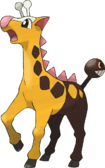

Girafarig is quite a unique Pokemon. It appears to be closely linked to the biological genus Giraffa due to its lengthy neck and distinguished horns. Even the leopard-like spots on its hide indicate this close relation. Girafarig seems to differ, however, resides in its hindparts. Girafarig lack a normal tail; instead, they have an entirely different head on their behind. This second head has olfactory, gustatory, and optical functions and is capable of executing a variety of coordinated efforts, including biting (Pokemon Gold).
What is perhaps the most fascinating about Girafarig's secondary head is that it houses an entirely different brain of its own. Many have assumed that Girafarig have only one brain that controls the functionality of the other half, but modern science has found that this is not the case. Further examination has shown that the second head has its own brain; how much functionality it has independent of the primary brain is up for debate. However, there is evidence that when Girafarig sleep, its rear end will stay up all night and keep guard (Pokemon Sapphire). Figure 203.1 shows the integrated connection between the two brains of Girafarig. Both nerve cords extend from the respective medulla oblongata and travel down the spinal cord, where they then meet at bodily division, which is easily distinguishable from noting the change in color of Girafarig's hide. Both brains contain their communication center at the dorsal side of the brain.
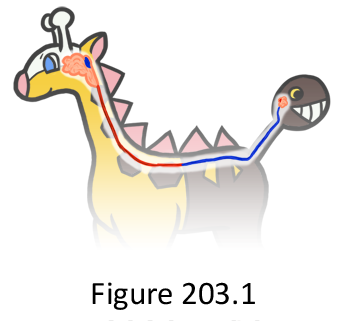
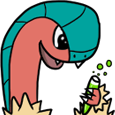
An additional brain may seem like an oddity in the natural world. Polycephaly is usually a condition in which two separate creatures are joined before birth. The condition usually results in a poor quality of life for the creatures involved with animals dying young. This is not so uncommon in the world of Pokémon. Some Pokémon are in fact several that become bound together later in life such as Magneton and Weezing. Other Pokémon are single organisms that grow or split off additional brains such as Dodrio and Zweilous.
Girafarig is unusual in the sense that its brain is situated in the tail at the end of the spinal cord instead of splitting into its own spinal column as demonstrated by Dr. Birkal. It is also far less intelligent than those examples. This makes it unlikely that the Pokémon's additional brain was the result of a duplication of its existing brain and probably developed independently.
A feasible way the tail could have occurred is if a part of the autonomic nervous system and reflex arcs near or in the tail expanded and gained duplicate sensory organs. The autonomic nervous system is responsible for the unconscious control of bodily organs like digestion and reflex arcs are responsible for automatic responses to stimuli such as leaping away from a source of pain. Some parts of the autonomic system can work in tandem with the conscious brain allowing for manual control of functions like breathing. This would help explain behavours such as the tail chewing while the main mouth eats since the tail is not truly independent of the main brain.
A reason for this extra head may simply be one of self defense. The tail is reactionary and will automatically attempt to bite people or other Pokémon when met with certain stimuli, mainly smell or touch. Its teeth are jagged and many which will cause numerous puncture wounds as well as holding the threat in place to be kicked. This wards off predators from a Girafarig's vulnerable hindquarters while browsing. It also serves as a warning system while the Pokémon sleeps since the extra head doesn't have faculties that require sleep.
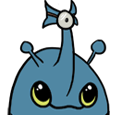
I am thoroughly disappointed about the research done on Girafarig so far, as essentially all pokedex entries decided to focus on the tail's properties and then repeat said facts over and over in the later versions. Because I could really appreciate a dissection log of the frontal brain right now. Or any other observations, really.
With that glaring void of knowledge in mind, I will dare to presume that the tail's tiny excuse for a brain is not additional to the frontal brain, but rather separate. The difference is that this enables Girafarig to distribute some of its mental burden to its tail, and thus be able to focus more of its efforts on different tasks, mainly psychic and physical performances. But this is still only on a theoretical level as there's still little to know about the synergy between the two brains. Or if it's even there in the first place.
But I'm sticking to my assumption that the front head has the means to maintain a higher degree of neurological acitivity, while its rear merely contains basic senses and instinctive behaviour, thus constituting the 'normal' part of Girafarig's dual type. Which is assuming that a separate head in the form of a tail with a tendency for spontaneous biting can be considered normal, but I believe someone was working on a proper definition for that type and I'm eager to read the conclusion.
As the head provides additional surveillance and is beyond the need to sleep, its two abilities which prevents flinching and reduces the time required to sleep are both explained to an extent. So basically, nothing will return and bite Girafarig in the ass any time soon. If anything, the opposite is much more plausible.
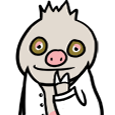
Girafarig's "hind brain" is a major anomaly and a challenge for developmental biology. Like most Pokemon, Girafarig's anatomy follows a bilateral symmetry - you can slice it in half to produce mirror-image halves, but more importantly it has a front end and a back end. The determination of anterior and posterior positions occur when Pokemon are still an embryo, and the Pokemon's anatomy develops inside its egg according to this basic body plan. The anus would be located in the posterior, whereas the mouth would be located in the anterior. This body plan also allows the concentration of sensory equipment and the brain on the anterior end. The general body plan allows Pokemon to face its wild-life challenges from the front while leaving its wastes behind.
Girafarig seemingly defies this conventional anatomical development, and ends up with what is clearly a rudimentary face on its tail (with teeth and all)! As presented by Dr. Birkal's figure, the fact that the two brains share the same spinal cord implies that they both originated from the same neural tube, which also organizes the Pokemon's neural network in accordance to the anterior-posterior body plan. Truly a biological wonder!!!
Bringing our attention back to the tail, I find it hard to believe that the tail, with a mind of its own, does not sleep. Sleep is necessary to restore brain function and maintain the cyclical pattern of neural activity - it's improbable that the hind brain is on high gear 24/7. The hind brain may have adopted a shark-like "light sleep" schedule, where one hemisphere of the brain turns off while the other is still active. Therefore, each half of the brain gets to rest while the tail still maintains its guard - sleep biting if you will!
Parasect: The Mushroom Pokemon
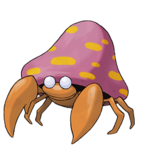

Parasect, which my colleagues and I are cultivating in search for a possible anti-cancer chemical agent, are sad sights to behold. The mushroom parasites on their backs have bloomed three times the size of their Parasect hosts, virtually squashing these powerful insects under the fungus’s weight (no wonder it's one of the slowest Pokemon around). Like other fungal parasites of insects, the spores of this mushroom germinatee when the time is ripe, infiltrating Paras's spiracles, which serve as airways, with its nutrient-absorbing hyphae. As Paras grows into Parasect, the mushroom gains dominance of Parasect's nutrient source, sprouting beautifully on Parasect's stunted body. My lab recently discovered that Parasect's immune system is on high-drive in response to the growing mycelium formed by the mass of hyphae inside its body, producing proteins that retard the expansion of the fungal web of demise. This compound has allowed Parasect to delay the complete hi-jacking and annihilation by the fungi long enough to live a "rich and meaningful" life. However, the fungus has firmly rooted itself during the initial life-stage of Parasect, when it was only a Paras and its immune system not fully matured. The mushroom has always ended up winning the war of attrition, its exotic and dreadful body triumphantly anchored onto the collapsed shell of the valiant insect, ready to invade nearby colonies of Paras.

The Parasect family is always a reliable subject if one gets the itch to discuss unfortunate and unethical occurrences in the pokémon world, because what this shroom is doing is nothing short of a complete heist of the bug's being. Which, for most people, can be taken as a sad turn of events. But I like to amuse myself with the thought that the predecessor of Paras might actually be better off as a mindless drone. Sure, turning into part vegetable may be against its will, but with that non-mutual transformation comes a vast number of options which enables the bugger to expand its defensive and offensive arsenal. At this point, we don't actually KNOW if a deshroomed Paras would evolve into something different, or stay as a vulnerable cave-dwelling insect doomed to fear anything which resists claws. So even if the large fungus rules over its brain with an iron root, odds are that Parasect would be insignificant without it. It being the primary and only victim of the mushroom's infectious properties could even be a proof that this bug is the only thing weak enough to trigger this turn of events.
But since I have no actual observations to support my theory, this is still just a huge 'maybe'. So if we were to jump back to the victim perspective, the life of a Paras is essentially predetermined and inevitable. The move Spore is one of the few things which made the Parasect family notorious for quite some time, but just how defendable is it to spread the seeds of tyranny during battle so that you may score a few turns of sleep among your opponents? The spores only manage to induce momentary sleep when used directly, but we can only begin to wonder if there are any longterm drawbacks for those who are outside the Parasect family. Degenerated nerve activity? Abnormal behaviour? Athlete's foot? We can only guess. And wait.
With that said, I do like Parasect. Whenever it responds with a small gesture of affection, I'd like to believe that there's still a small trace of the bug's mind left in there which can act and think on its own. Or it's the shroom which lulls me into a false sense of safety as it plans the next hostile takeover. I, for one, am fine with both scenarios.

I question what kind of laboratorial work Professor Pocket and his team are doing; searching for anti-cancer chemicals within a parasitic fungus seems highly questionable, in my humble opinion. Regardless, he has done a substantial job of covering the basics of the strange relationship between one bug and its toadstool. My chief area of interest with regard to Parasect is exactly what occurs when the fungus does not gain full cerebral control over the host organism. What are the behavioral mechanisms and communication functions of the bug truly like? I’d hypothesize that the invertebrate would be completely unable to communicate with its controlled brethren. Furthermore, it brings to question whether or not Parasect can actually breed or not without the aid of a spore-generating shroom. Perhaps the relationship between the two species is more symbiotic than we have assumed in the past. I am excited to see what bits and pieces of research will develop over the next few years on Parasect and relationship it shares between fungus and bug.

Professer Bummer brought up a very valid topic. What does Parasect's spores do to a Pokémon long term? Well my team has been looking into that. We performed a series of tests on several species of Pokémon including, Ratata, Nidoran and Chimchar and have found that the spores don't appear to have any lasting effects. All subjects have been shown to be just as healthy as the control group at most dosages. At extremely high dosages, ten times more than a Parasect produces during an attack, it may asphyxiate the affected while asleep. It appears that repeated exposure doesn't cause harm.
So far our results show that the spores Parasect produce are primarily for defense. Spores today are only used for their purposes of reproduction after the Paras or Parasect breeds to infect their eggs. So why does it do so little harm to other Pokémon? The key may lie in the past, where healthy Paras once existed. A method of incapacitating the host without harming it is extremely beneficial to a parasite and may have been the key to the fungi's success.
As a final note, to all mushroom maniacs. No the fungus is not an aphrodesiac and will not cure your, problems. Stop asking.
| « Previous Article | Home | Next Article » |